The Spatio-Temporal Evolution of Food Production and Self-Sufficiency in China from 1978 to 2020: From the Perspective of Calories
Abstract
1. Introduction
2. Data and Methods
2.1. Data Sources
2.2. Research Methods
2.2.1. Local Food Supply Estimation
2.2.2. Food Calorie Yield Model
2.2.3. Food Calorie Supply–Demand Model
2.2.4. Spatio-Temporal Evolution Analysis
3. Results
3.1. Trends in Regional Food Calorie Production
3.2. Calorie production in Different Food Categories
3.3. Provincial Food Calorie Production
3.4. Local Food Calorie Supply and Demand
4. Discussion
5. Conclusions
Author Contributions
Funding
Institutional Review Board Statement
Informed Consent Statement
Data Availability Statement
Conflicts of Interest
References
- Food and Agriculture Organization. Food Security and Nutrition in the World Nations; Food and Agriculture Organization: Rome, Italy, 2020. [Google Scholar]
- Kang, S.Z. Towards water and food security in China. Chin. J. Eco-Agric. 2014, 22, 880–885. [Google Scholar]
- Chen, Y.F.; Wang, J.Y.; Zhang, F.R.; Liu, Y.S.; Cheng, S.K.; Zhu, J.; Si, W.; Fan, S.G.; Gu, S.S.; Hu, B.C.; et al. New patterns of globalization and food security. J. Nat. Resour. 2021, 36, 1362–1380. [Google Scholar] [CrossRef]
- Jiao, X.; Mongol, N.; Zhang, F. The transformation of agriculture in China: Looking back and looking forward. J. Integr. Agric. 2018, 17, 755–764. [Google Scholar] [CrossRef]
- Liu, W.; Yang, H.; Ciais, P.; Kummu, M.; Hoekstra, A.Y. China’s food supply sources under trade conflict with the United States and limited domestic land and water resources. Earth’s Future 2020, 8, e2020EF001482. [Google Scholar] [CrossRef]
- Si, W.; Zhang, Y.M.; Fan, S.G. How to ensure food and nutrition security under the COVID-19 epidemic: A global perspective. Issues Agric. Econ. 2020, 3, 11–16. [Google Scholar]
- Wang, Q.; Yue, T.X.; Fan, Z.M.; Sun, X.F.; Xin, X.P. Spatial-temporal patterns of food provision in Jiangxi province. Prog. Geogr. 2011, 30, 479–484. [Google Scholar]
- Wang, L.Y.; Xiao, Y.; Rao, E.M.; Jiang, L. Spatial characteristics of food provision service and its impact factors in China. J. Nat. Resour. 2015, 30, 188–196. [Google Scholar]
- Liu, Z.J.; Zhong, H.M.; Li, Y.R.; Wen, Q.; Liu, X.Q.; Jian, Y.Q. Change in grain production in China and its impacts on spatial supply and demand distributions in recent two decades. J. Nat. Resour. 2021, 36, 1413–1425. [Google Scholar] [CrossRef]
- Xin, L.J. Dietary structure upgrade of China’s residents, international trade and food security. J. Nat. Resour. 2021, 36, 1469–1480. [Google Scholar] [CrossRef]
- Xin, L.J.; Wang, J.Y.; Wang, L.X. Prospect of per capita grain demand driven by dietary structure change in China. Resour. Sci. 2015, 37, 1347–1356. [Google Scholar]
- Cao, Z.H. Changes in Chinese food consumption and agricultural production requirements based on cereal equivalent. Resour. Sci. 2013, 35, 2181–2187. [Google Scholar]
- Wang, Y. The challenges and strategies of food security under rapid urbanization in China. Sustainability 2019, 11, 542. [Google Scholar] [CrossRef]
- Beltran-Pena, A.; Rosa, L.; DOdoroco, P. Global food self-sufficiency in the 21st century under sustainable intensification of agriculture. Environ. Res. Lett. 2020, 15, 95004. [Google Scholar] [CrossRef]
- Tilman, D.; Balzer, C.; Hill, J.; Befort, B.L. Global food demand and the sustainable intensification of agriculture. Proc. Natl. Acad. Sci. USA 2011, 108, 20260–20264. [Google Scholar] [CrossRef]
- Pompeu, J.; Nolasco, C.L.; West, P.; Smith, P.; Gerage, J.; Ometto, J. Is domestic agricultural production sufficient to meet national food nutrient needs in Brazil? PLoS ONE 2021, 16, e0251778. [Google Scholar] [CrossRef]
- Wang, Q.; Yue, T.X.; Lu, Y.M.; Du, Z.P.; Xin, X.P. An analysis of the capacity of China’s food provision. Acta Geogr. Sin. 2010, 65, 1229–1240. [Google Scholar]
- Wang, Q.; Yue, T.X.; Lu, Y.M.; Fan, Z.M.; Xin, X.P.; Zhang, H.B. Analysis of cultivated land food supply-demand-equilibrium in China. Resour. Sci. 2010, 32, 1710–1717. [Google Scholar]
- Zhang, Y.; Gao, X.; Zhang, H. Supportable capability of Chinese agriculture. J. China Agric. Univ. 2013, 18, 224–230. [Google Scholar]
- Pekka, K.; Joseph, H.A.G.; Maija, T.; D’Odorico, P.; Siebert, S.; Puma, M.J.; Jalava, M.; Kummu, M. Local food crop production can fulfil demand for less than one-third of the population. Nat. Food 2020, 1, 229–237. [Google Scholar]
- Huang, Z.Y.; Guo, Y.Z.; Sun, J.M. Seed input-output efficiency, feed grain conversion efficiency and food and nutrition security. J. Agric. Sci. Technol. 2019, 21, 17–26. [Google Scholar]
- Huang, S.; Liu, A.; Lu, C. Supply and demand levels for livestock and poultry products in the Chinese mainland and the potential demand for feed grains. J. Resour. Ecol. 2020, 11, 475–482. [Google Scholar]
- Ghose, B. Food security and food self-sufficiency in China from past to 2050. Food Energy Secur. 2014, 3, 86–95. [Google Scholar] [CrossRef]
- Food and Agriculture Organization. Global Food Losses and Waste Nations; Food and Agriculture Organization: Rome, Italy, 2011. [Google Scholar]
- World Wide Fund For Nature. Report on Food Waste in Chinese Cities; World Wide Fund For Nature: Beijing, China, 2018. [Google Scholar]
- Wang, L.E.; Ni, X.W.; Li, Y.Y. Measurement of the scale of food waste and its resources and environmental effects at the consumer segment in China. J. Nat. Resour. 2021, 36, 1455–1468. [Google Scholar] [CrossRef]
- Li, X.; Liu, X.J.; Cheng, G.Y.; Hu, Y.C. China’s food loss and waste embodies increasing environmental impacts. Nat. Food 2021, 2, 519–528. [Google Scholar]
- Liu, G. Food Losses and Food Waste in China; OECD: Paris, France, 2014. [Google Scholar]
- Luo, Y.; Li, X.F.; Huang, D.; Wu, L.P. The progress and prospects of research on food loss and waste. J. Nat. Resour. 2020, 35, 1030–1042. [Google Scholar]
- Cao, B.M.; Jiang, D.B. The situation, causes and countermeasures of grain postpartum loss in Jiangsu. J. Nanjing Univ. Financ. Econ. 1999, 1, 21–27. [Google Scholar]
- Zhan, Y.R. Sampling survey and analysis of grain postpartum loss in China. China Grain Econ. 1995, 4, 44–47. [Google Scholar]
- Zhang, J.; Fu, Z.T.; Li, D.L. Formation of grain loss and current situation of grain loss in China. J. China Agric. Univ. Soc. Sci. 1998, 12, 59–63. [Google Scholar]
- Chi, R.Y. Research on behavior control model of grain postharvest losses. Bull. Sci. Technol. 1997, 3, 51–54. [Google Scholar]
- Chen, Y.F.; Zhong, Y.; Liu, Y. Management situation and policy implications of China’s grain security. Res. Agric. Mod. 2014, 35, 690–695. [Google Scholar]
- Yang, L. Analysis of grain yield forecast based on intervention model. Adv. Soc. Sci. 2017, 6, 955–963. [Google Scholar]
- Cheng, S.K.; Wang, S.Y.; Liu, X.; Liu, X.; Wu, L. Food nutrition and food security of China in a new development phase. Chin. Sci. Bull. 2018, 63, 1764–1774. [Google Scholar] [CrossRef]
- Gao, Q.S.; Shen, S. Research on the space-time evolvement and coupling relationship of the gravity center of China’s agriculture economy and its agriculture labor. Territ. Nat. Res. Study 2021, 3, 48–53. [Google Scholar]
- Zhao, X.; Liu, J.; Liu, Q. Physical and virtual water transfers for regional water stress alleviation in China. Proc. Natl. Acad. Sci. USA 2015, 112, 1031–1035. [Google Scholar] [CrossRef] [PubMed]
- Ning, J.; Liu, J.; Kuang, W. Spatiotemporal patterns and characteristics of land-use change in China during 2010–2015. J. Geogr. Sci. 2018, 28, 547–562. [Google Scholar] [CrossRef]
- Yu, D.M.; Zhao, L.Y.; Ju, L.H. Status of energy and primary nutrients intake among Chinese population in 2015–2017. Food Nutr. China 2021, 27, 5–10. [Google Scholar]
- Wood, S.A.; Smith, M.R.; Fanzo, J. Trade and the equitability of global food nutrient distribution. Nat. Sustain. 2018, 1, 34–37. [Google Scholar] [CrossRef]
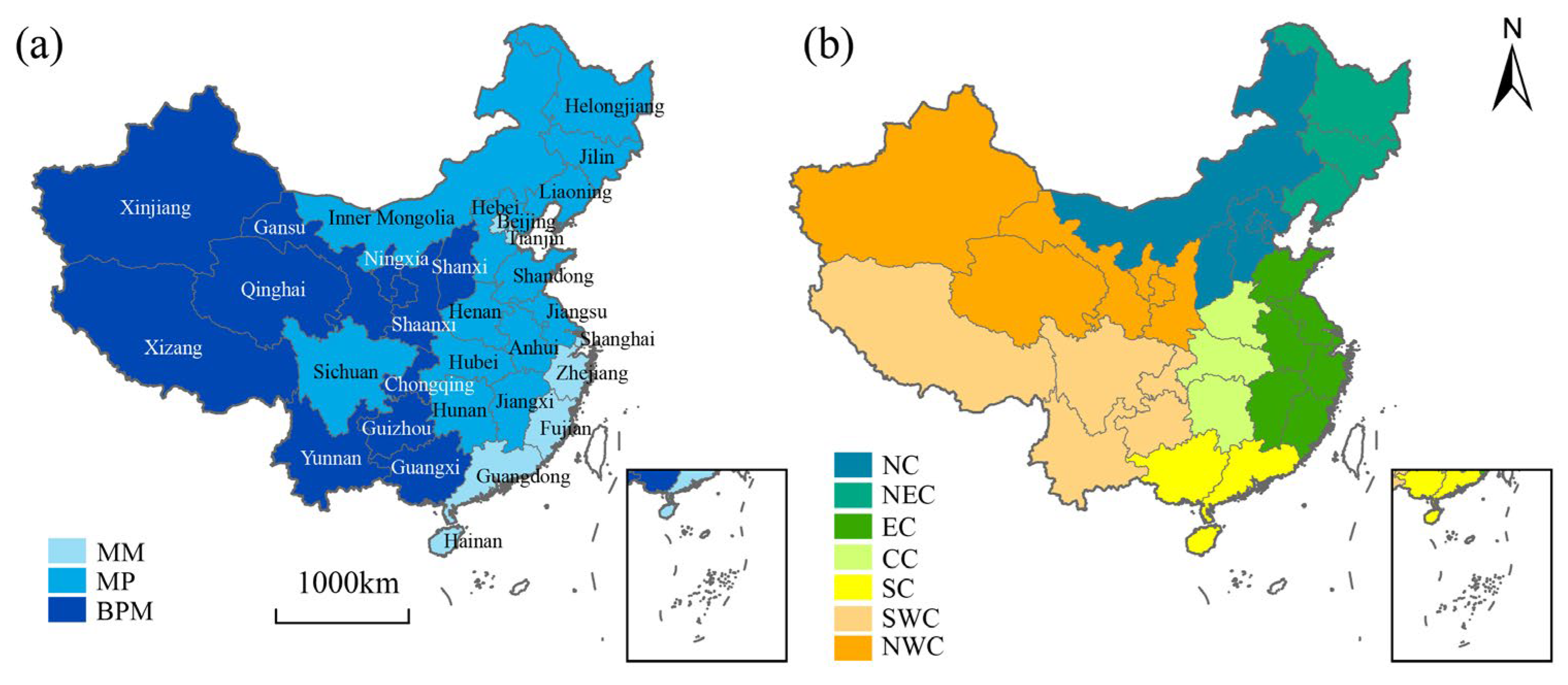

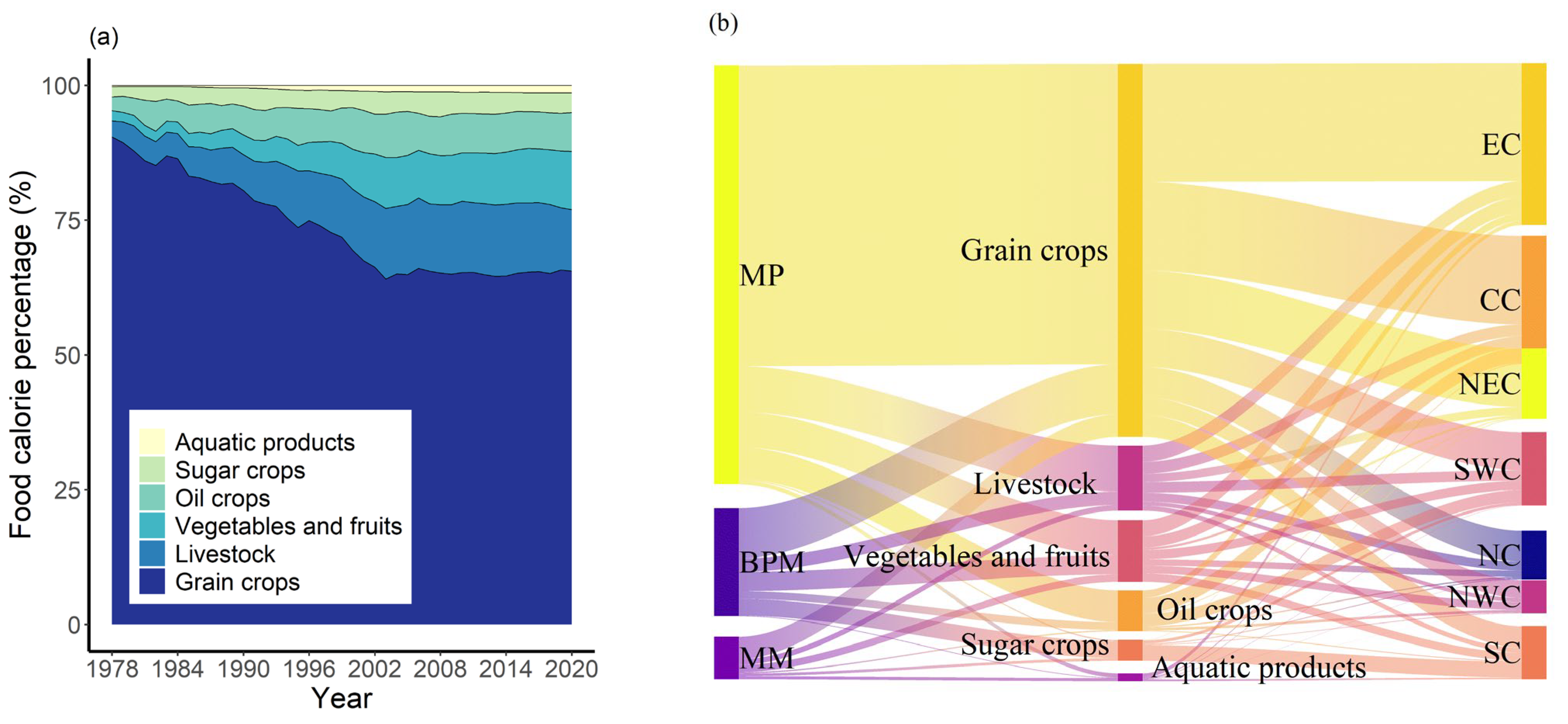


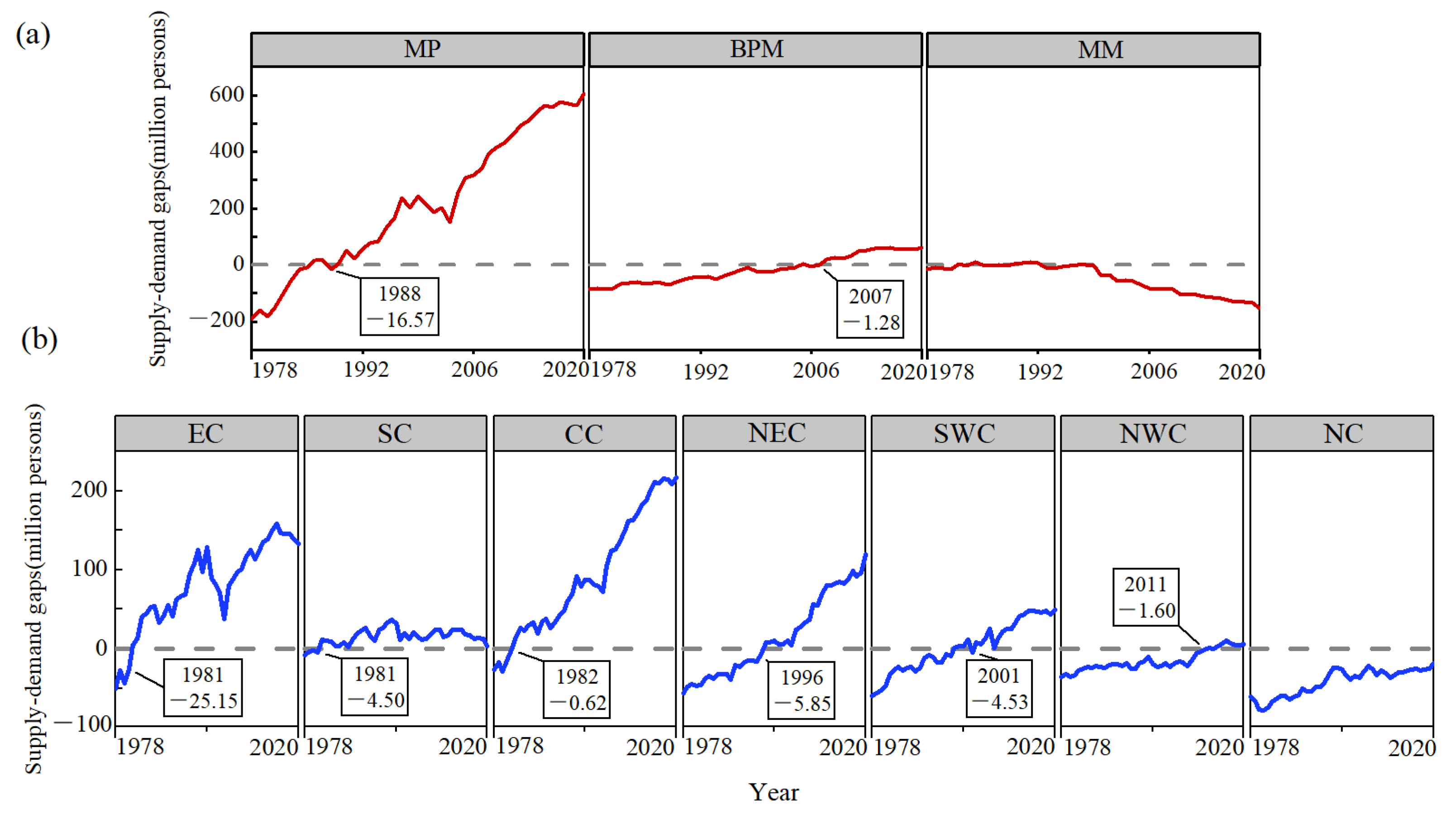
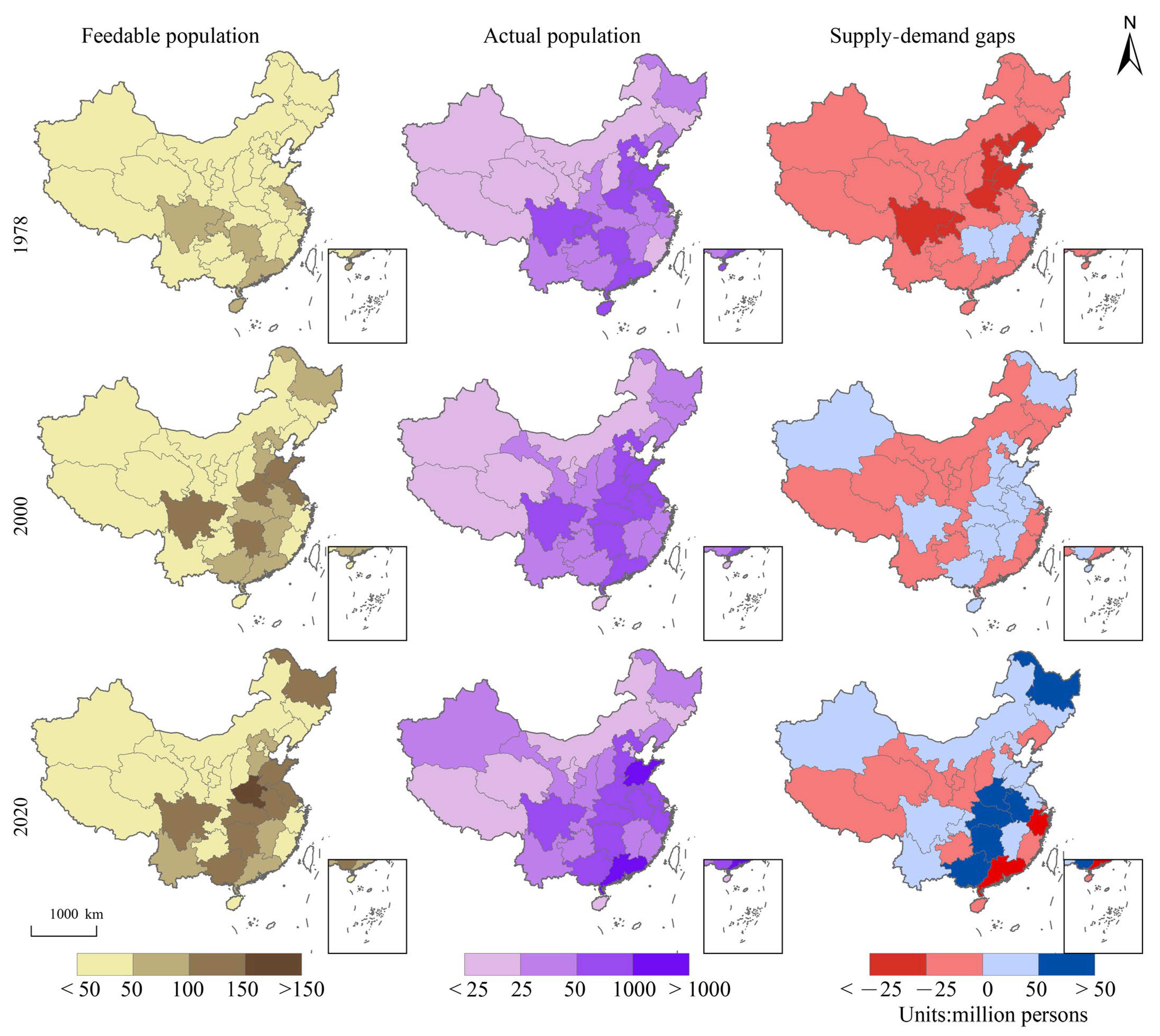
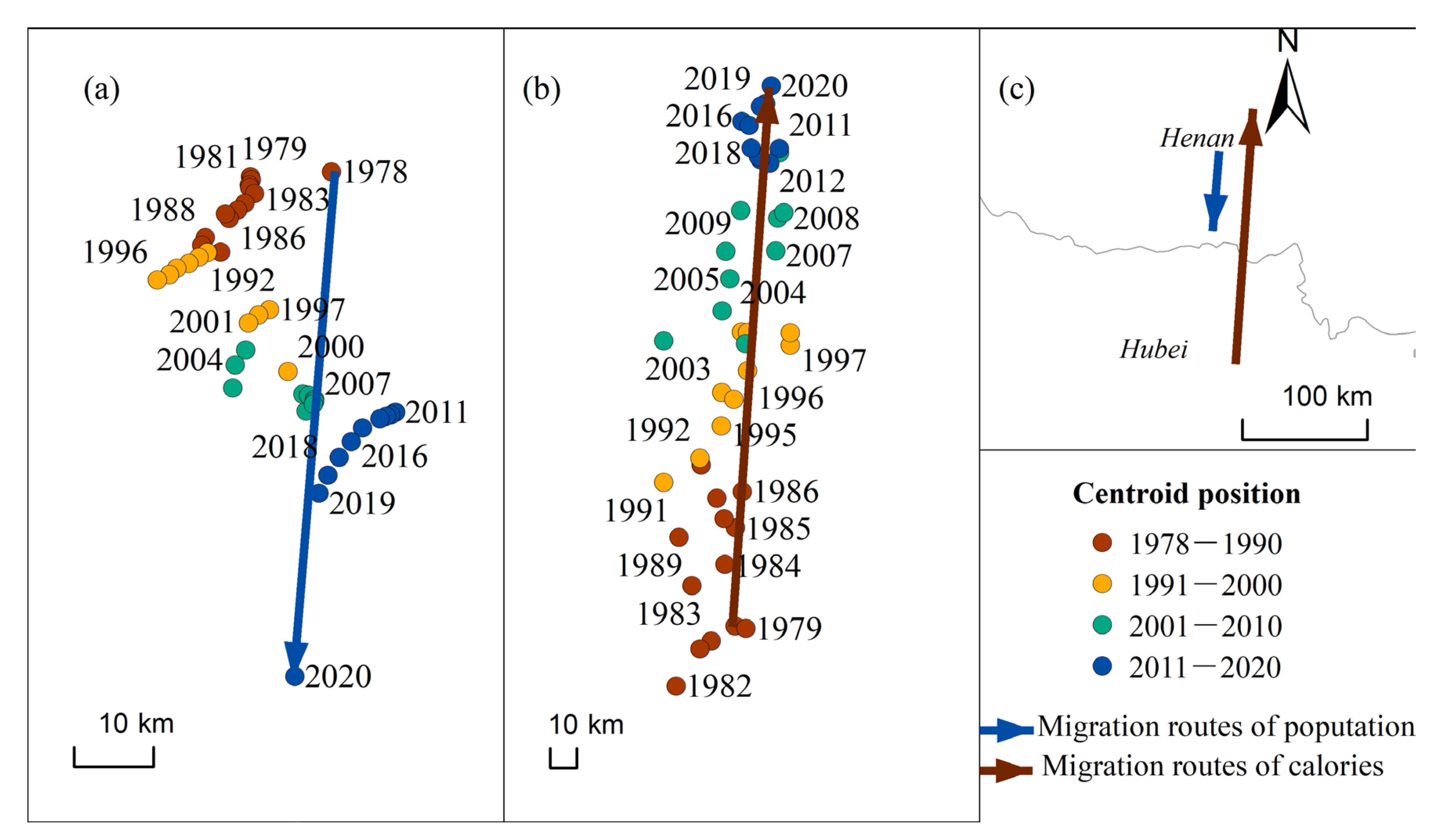
| Category | Food | EP (%) | (kcal) | Category | Food | EP (%) | (kcal) |
|---|---|---|---|---|---|---|---|
| grain crops | rice | 100 | 346 | oil crops | peanut | 53 | 313 |
| maize | 46 | 112 | rapeseed | 100 | 499 | ||
| tuber | 92 | 93 | sugar crops | sugar cane | 100 | 64 | |
| wheat | 100 | 338 | beet | 95 | 55 | ||
| soybean | 100 | 390 | vegetables and fruits | vegetables | 93 | 24 | |
| livestock | beef | 100 | 160 | citrus | 77 | 44 | |
| mutton | 100 | 139 | grape | 86 | 45 | ||
| eggs | 87 | 167 | pineapple | 68 | 44 | ||
| honey | 100 | 65 | persimmon | 87 | 74 | ||
| pork | 91 | 331 | apple | 85 | 53 | ||
| poultry | 65 | 210 | pear | 82 | 51 | ||
| milk | 100 | 321 | banana | 59 | 93 | ||
| aquatic products | mean | 51 | 91 | red dates | 87 | 125 |
Disclaimer/Publisher’s Note: The statements, opinions and data contained in all publications are solely those of the individual author(s) and contributor(s) and not of MDPI and/or the editor(s). MDPI and/or the editor(s) disclaim responsibility for any injury to people or property resulting from any ideas, methods, instructions or products referred to in the content. |
© 2023 by the authors. Licensee MDPI, Basel, Switzerland. This article is an open access article distributed under the terms and conditions of the Creative Commons Attribution (CC BY) license (https://creativecommons.org/licenses/by/4.0/).
Share and Cite
Zhang, J.; Fang, Y.; Zheng, H.; Fan, S.; Du, T. The Spatio-Temporal Evolution of Food Production and Self-Sufficiency in China from 1978 to 2020: From the Perspective of Calories. Foods 2023, 12, 956. https://doi.org/10.3390/foods12050956
Zhang J, Fang Y, Zheng H, Fan S, Du T. The Spatio-Temporal Evolution of Food Production and Self-Sufficiency in China from 1978 to 2020: From the Perspective of Calories. Foods. 2023; 12(5):956. https://doi.org/10.3390/foods12050956
Chicago/Turabian StyleZhang, Jing, Yu Fang, Hua Zheng, Shenggen Fan, and Taisheng Du. 2023. "The Spatio-Temporal Evolution of Food Production and Self-Sufficiency in China from 1978 to 2020: From the Perspective of Calories" Foods 12, no. 5: 956. https://doi.org/10.3390/foods12050956
APA StyleZhang, J., Fang, Y., Zheng, H., Fan, S., & Du, T. (2023). The Spatio-Temporal Evolution of Food Production and Self-Sufficiency in China from 1978 to 2020: From the Perspective of Calories. Foods, 12(5), 956. https://doi.org/10.3390/foods12050956







